Another classic Edomae fish, Shima Aji or striped jack mackerel, fish with firm and luscious flesh with just the right amount of fat. Alright it’s name has the world Aji in it, it is not in the mackerel family and is not related to horse mackerel (Aji). It is more commonly known as Trevally in English.
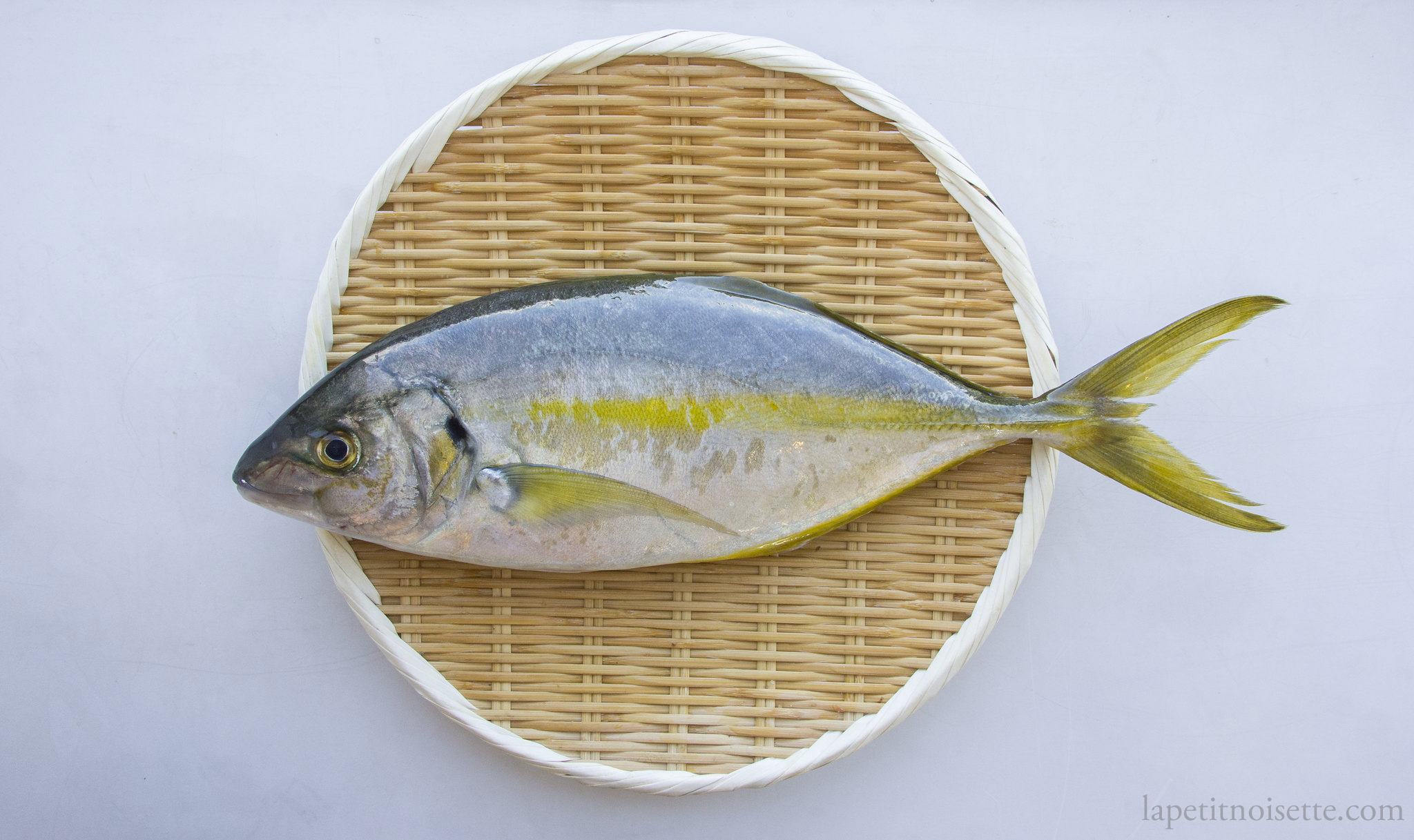
An expensive luxury fish, wild Shima Aji is extremely rare, with most Shima Aji used in restaurants being farmed ones. The farmed Shima Aji has a beautiful bluish green colour, whist wild Shima Aji is more grey. As a white flesh fish (Shiromi/白身), Shima Aji should have a mild delicate case. However, this is actually only true for wild Shima Aji. Farmed Shima Aji is fatty and almost oily, with a strong gelatinous flavour that coats your mouth. It is just as delicious, just in a different way.
Only people from an older generation now appreciate the taste of wild Shima Aji, as most younger people feel that wild Shima Aji is tasteless and lacks fat. In reality, wild Shima Aji has it’s own unique taste, it just doesn’t have the same appeal of fatty farmed ones, which resembles fatty tuna, which has increased in popularity.
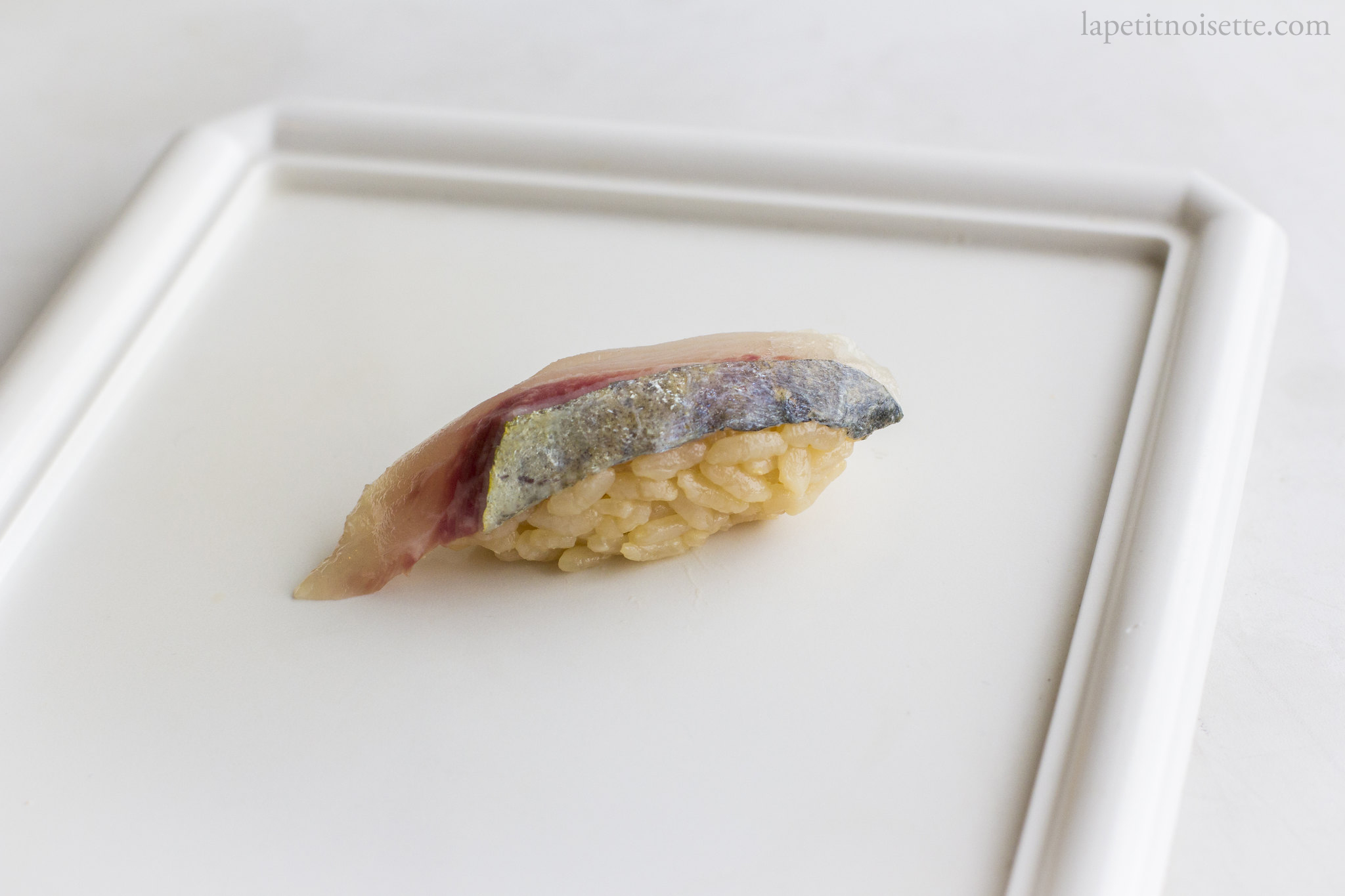
In this example, we only use a traditional fish scaler to scale the fish (urokotori/鱗取り). This is because the Shima Aji here is small and it’s scales are not so tough. In older and larger fishes, a hard scaled spine starts to develop near the tail. This additional armour needs to be removed using a knife to cut it.

We also marinade the Shima Aji in a little soy sauce and Sudachi lime juice. The sudachi line is small green citrus fruit unique to Japan that has the amazing aroma of pine cones and conifer forests.
Edomae-style preperation of Shima Aji (縞鯵):
After washing the fish in cold water, start by descaling the fish. We descale the fish using a urokotori (鱗取り), a traditional Japanese fish scaler. Run the scaler against the direction of scale growth to most efficiently remove them. Wash away the scales and slime with cold water. Whilst descaling, we run a small stream of cold water onto the fish from the tap to prevent any scales from flying about.
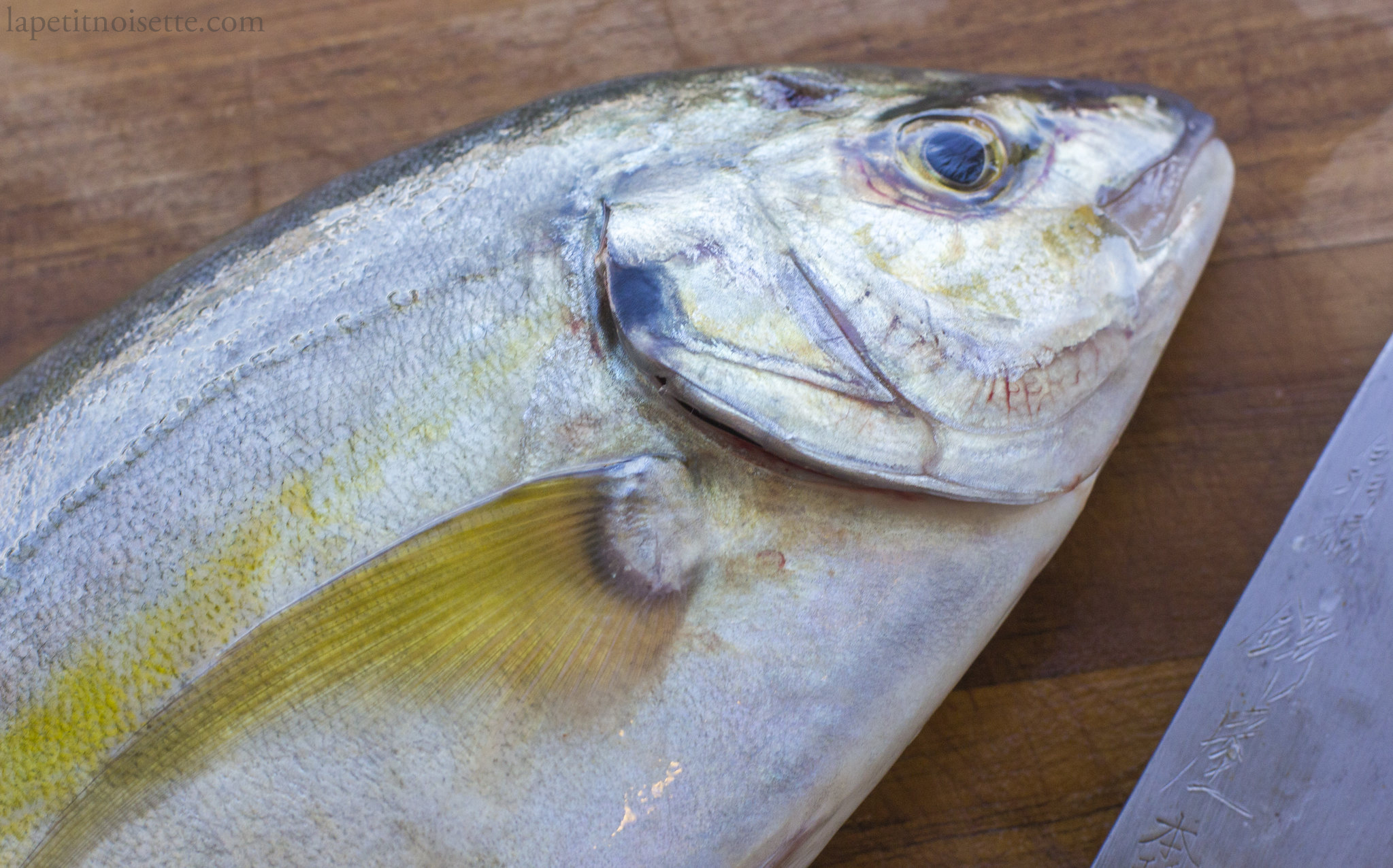
After descaling the fish, we remove the gills of the fish. Opening the gill flap, insert the tip of the knife into the gill cavity and cut the two ends of the gills connecting the arches.
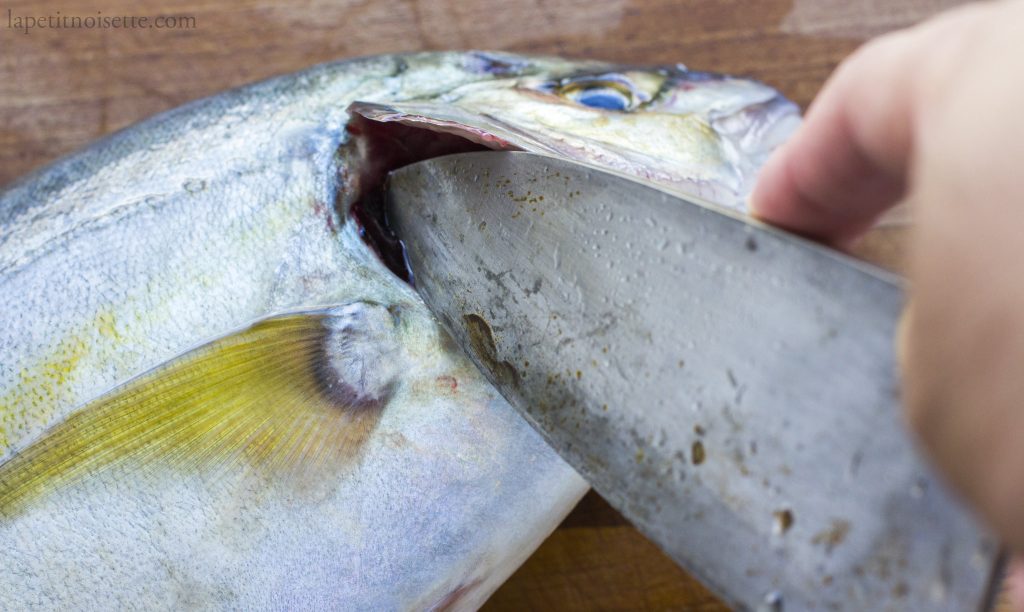
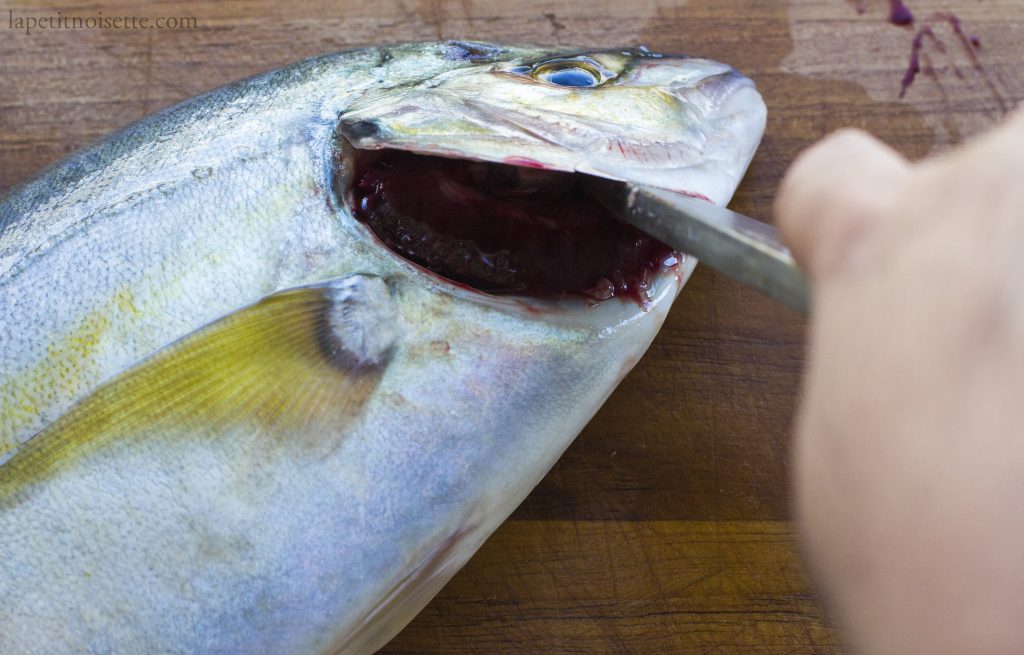
Next, break the bone connecting the collar of the fish to the head of the fish, allowing you to open the fish. Make a cut down the belly of the fish starting from just below the head all the way to the anus. The cut runs through the pelvic fins, separating them into right and left pelvic fin.
The flesh in between the pelvic fin is tough and will require some force. This is why the sharpness of the knife is important. Be careful not to cut yourself.
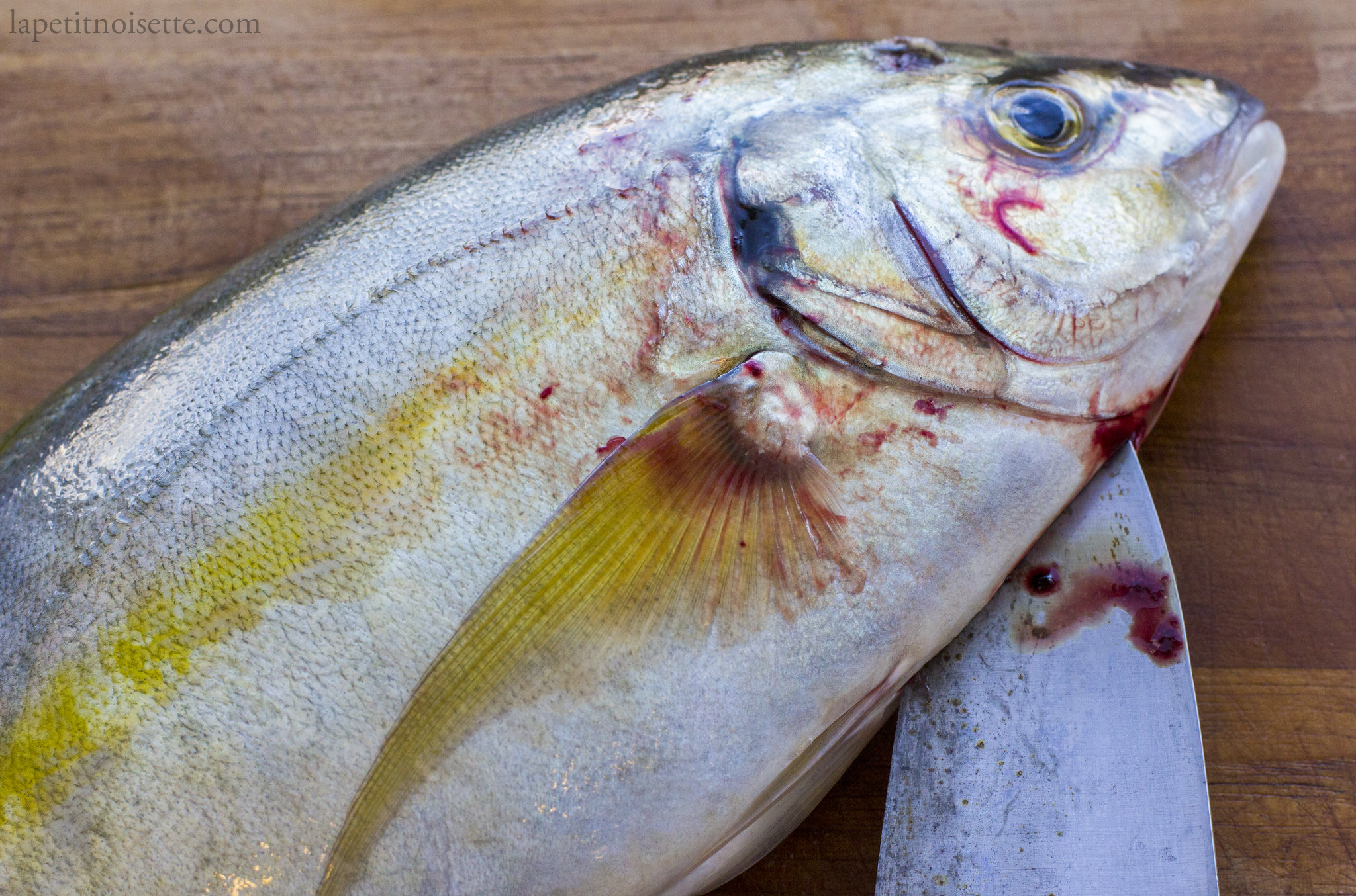
Open up the entire fish cavity and pull away the innards and gills, cutting away the point at which the gills are attached to the fish.
Rinse the cavity with cold water and clean throughly. Wash the chopping board and wipe dry. The cavity should be completely clean as any remaining dirt will rot during the ageing process.
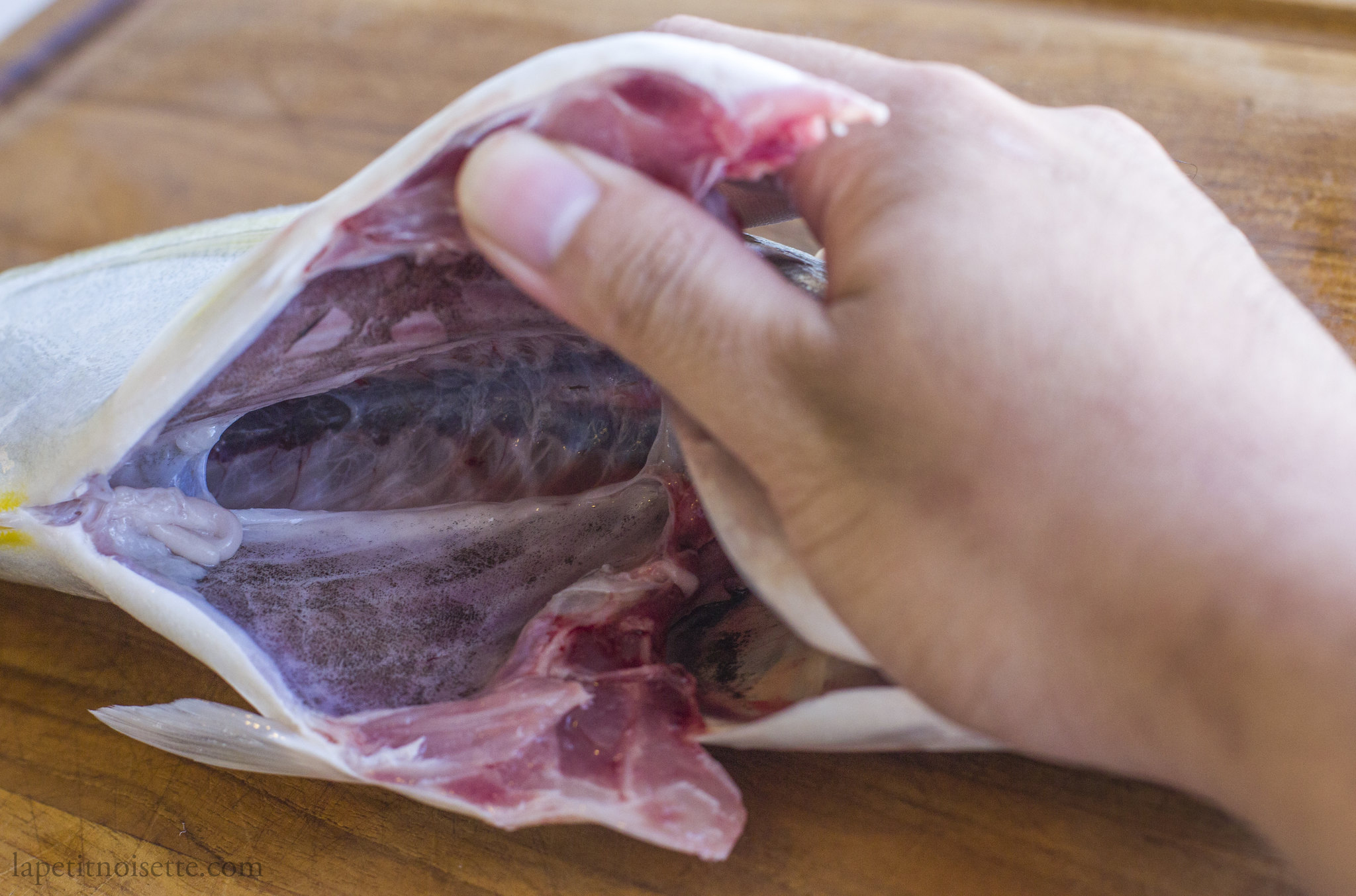
The fish’s air bladder is located at the centre of the cavity where the rib cage meets the backbone. The air bladder is connected to a blood line that needs to be removed. Cut open the bladder by running the knife through it all the way to the blood line underneath. Whilst under a light stream of cold water, wash the cavity and remove the blood from the blood line. Use an old toothbrush the remove and bit and pieces.
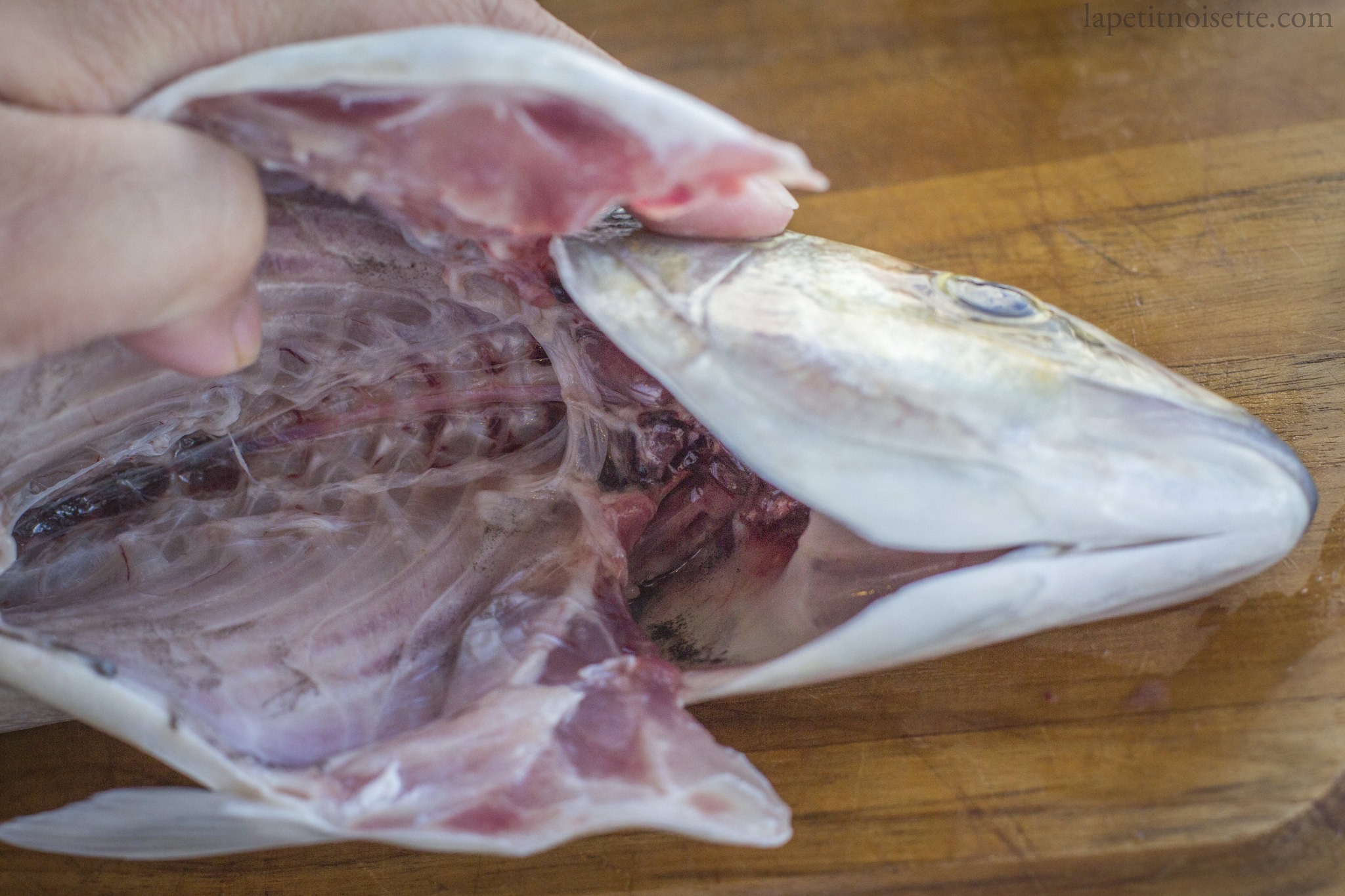
Insert fish paper (Magu roll/マグロッ) or paper towels into the stomach cavity and head cavity of the fish. This is to absorb any excess blood or moisture from inside the fish that would otherwise rot during ageing.
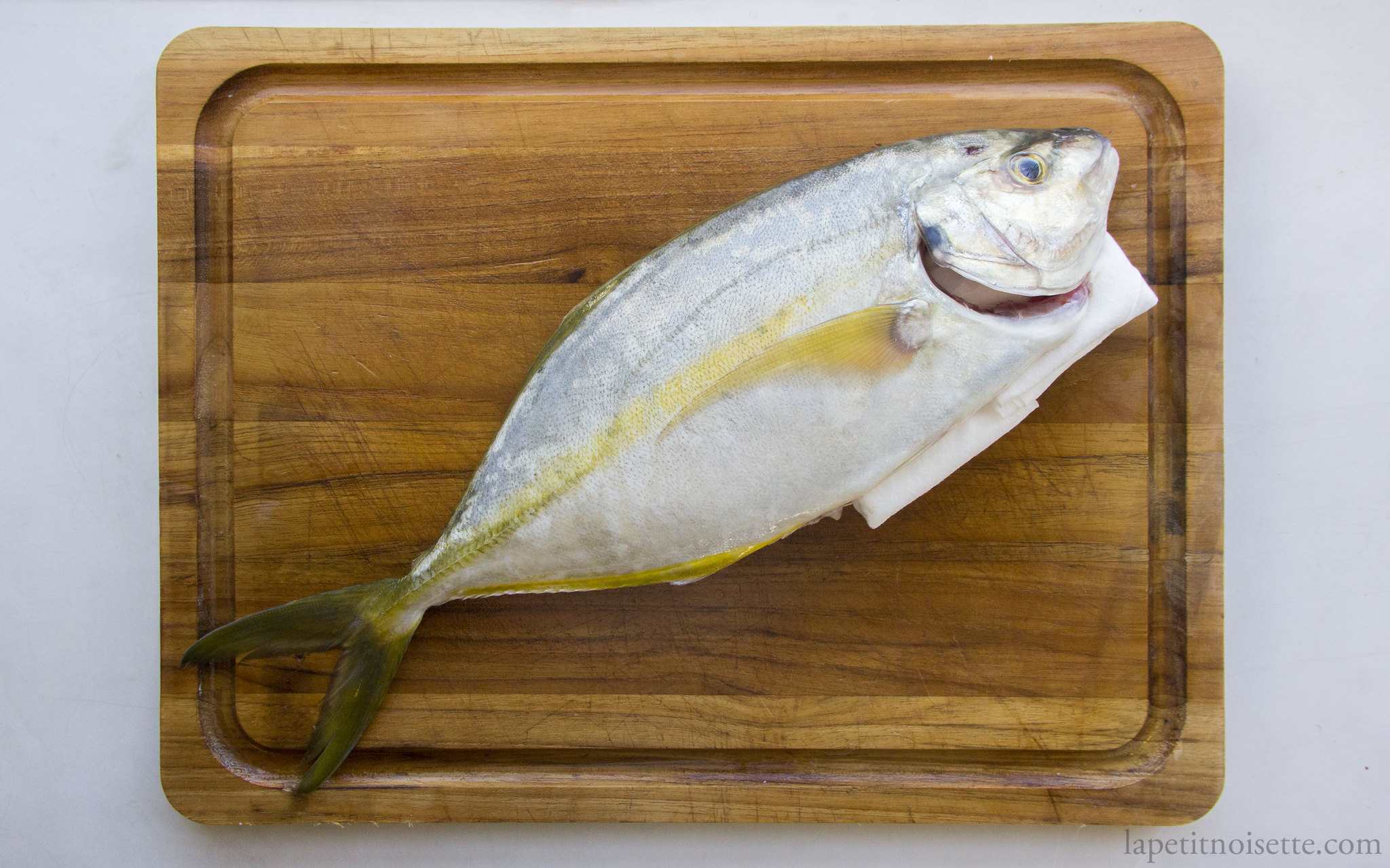
Place the fish inside a large plastic bag and remove all the air from the bag by bunching the end of the plastic bag together and sucking it out with your mouth. Alternatively use a vacuum pack machine. This minimises air exposure during ageing.
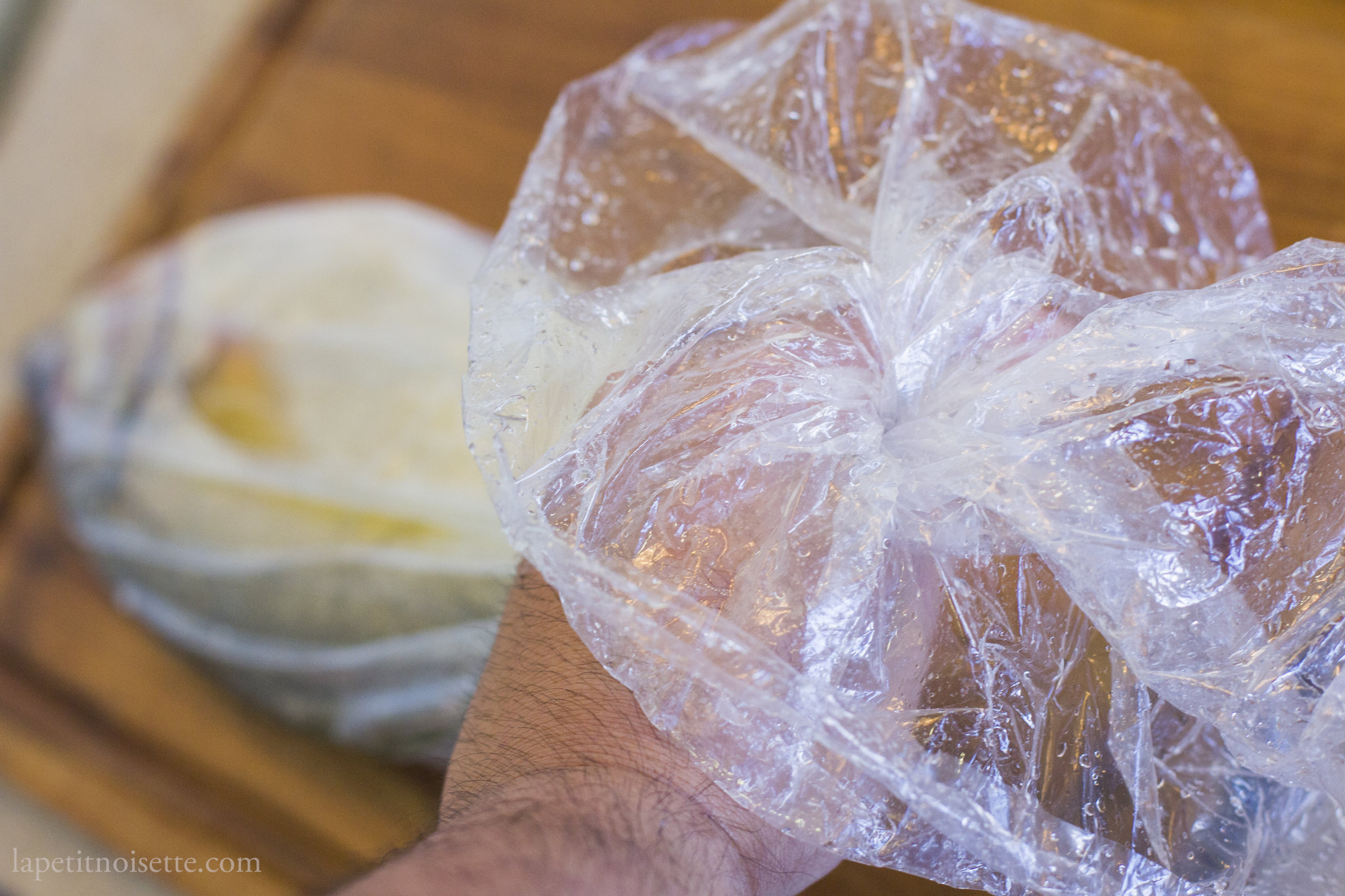
Tie the end of the bag to prevent any air from entering. Alternatively, if using a vac pack machine, the machine should automatically seal the bag.
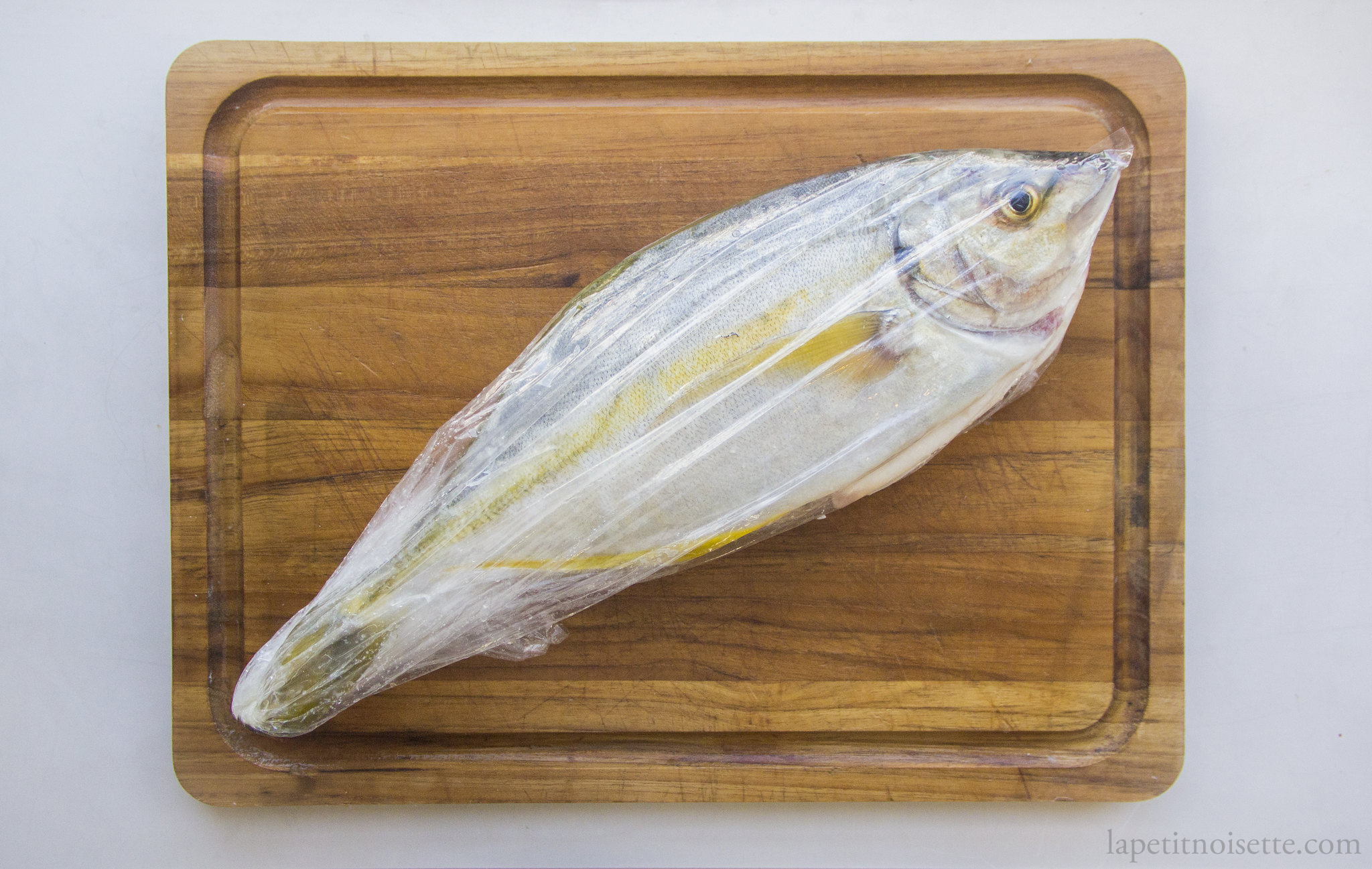
The fish is now ready for ageing. Place in a fridge set at 1-2°C for 1 to 2 days as described here.
After ageing, cut open the bag and remove the fish. Discard the paper towels and place the fish on a chopping board.
Remove the head of the fish and begin the filleting process. (Alternatively, remove the head after the filleting process)
Start by opening the internal cavity of the fish, inserting the tip of the knife and breaking the rib bones, separating them from the backbone.
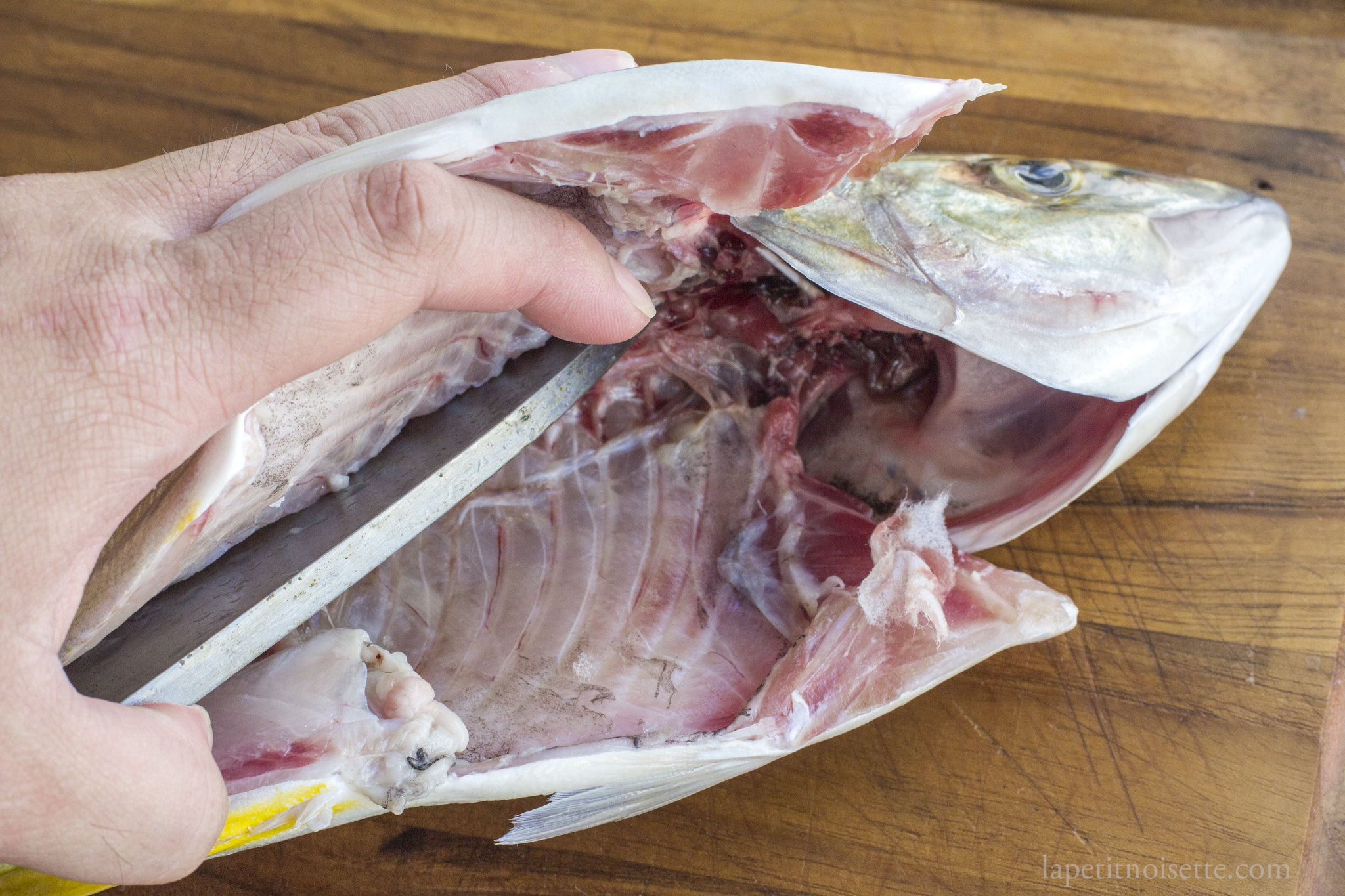
Next, the flesh starting from the end of the belly cavity all the way down to the tail, angling the blade towards the bone.
Turn the fish around and place the knife above the dorsal fin. Use your other hand to support the fish. In long cutting motions, separate the flesh from the spine of the fish, angling your blade downwards so that you can feel your blade running along the spine, minimising waste. if the long cutting motions prevents the flesh from being damaged too much from multiple cuts. Cut as close to the spine as possible to prevent flesh from being left on the bone.
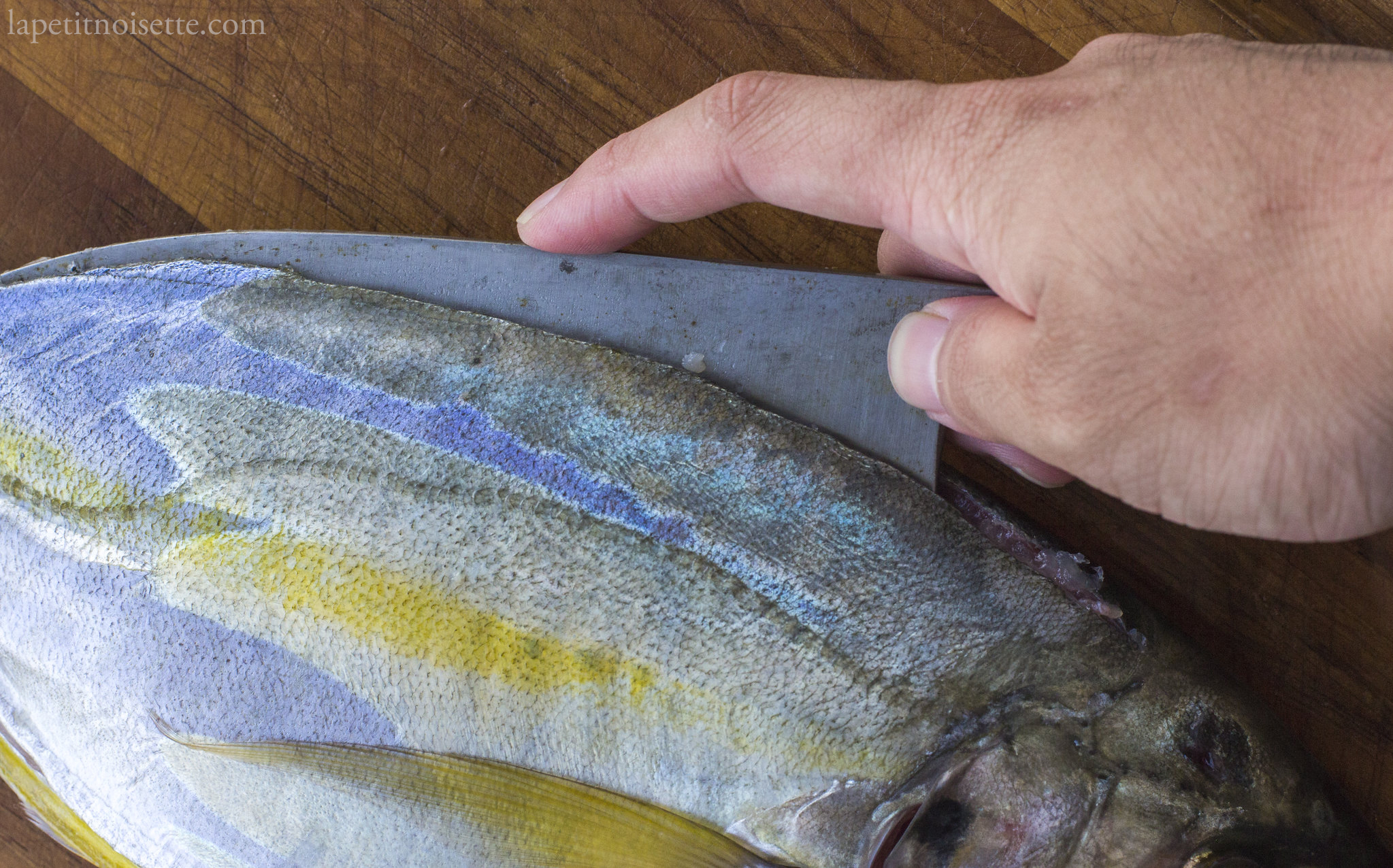
Continue the cutting motion until the entire fillet is separated from the fish. Making an incision at the tail of the fish and cut off the flesh attaching the fillet to the head.
Flip your knife so that it is facing upwards and gently separate the rib bones from the flesh just where it meets the pin bones.
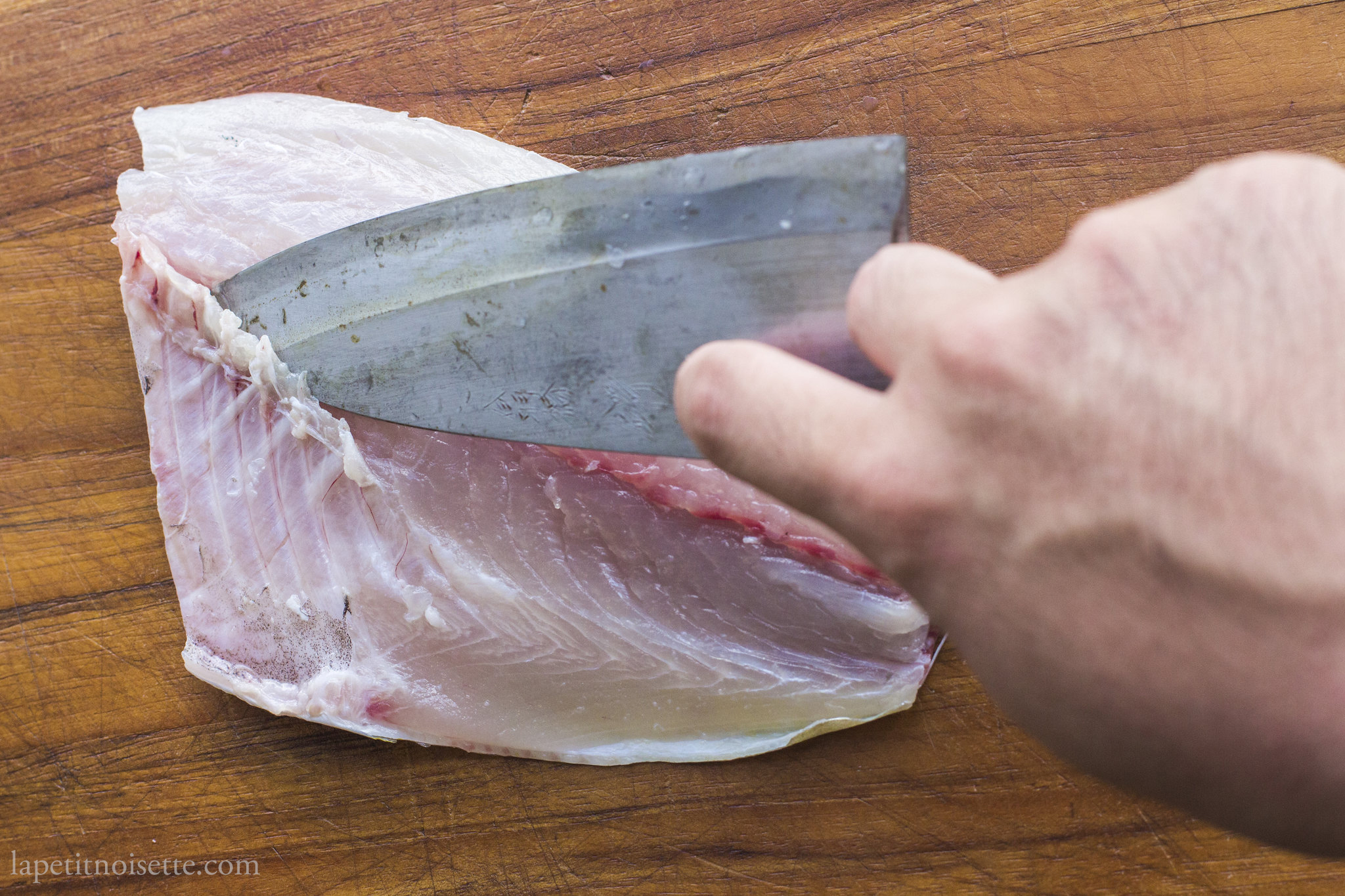
Turn your knife back and place the knife under the rib cage, cutting as to gently separate the rib cage from the flesh, angling the knife upwards towards the ribcage to reduce waste. Don’t worry about cutting yourself as the rib cage should be protecting your fingers.
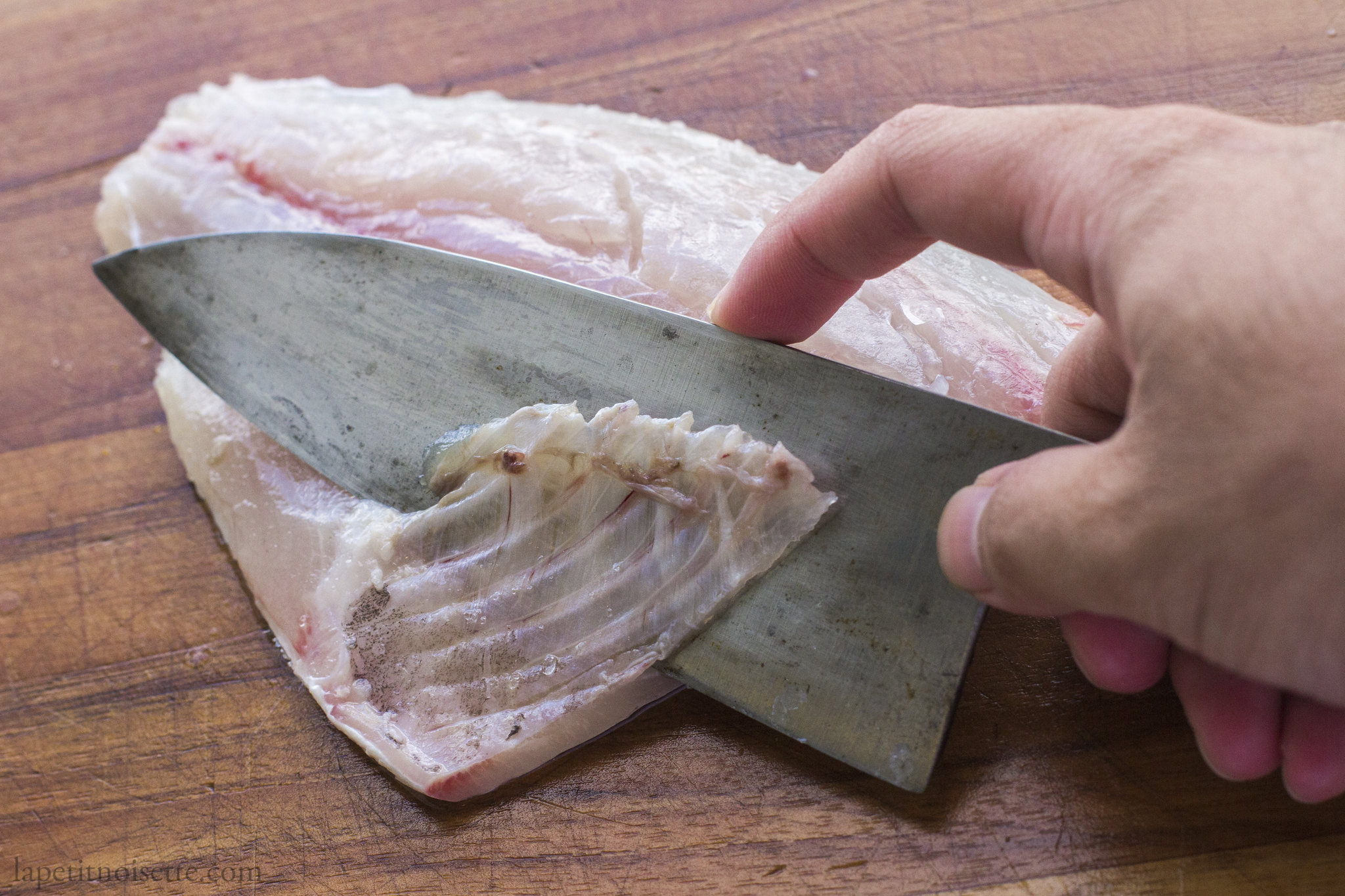
To remove the pin bones, pull the pin bones using a pair of tweezers in the direction towards the head. Pulling the pin bones towards the tail is easier but will damage the flesh. Dip the tweezers in water to clean them occasionally. Repeating until you can not feel anymore pin bones. Remember to use a firm grip as not to break the pin bones, leaving bone fragments inside the fish. It is better to pull the pin bones slowly and steadily, rather than quickly.
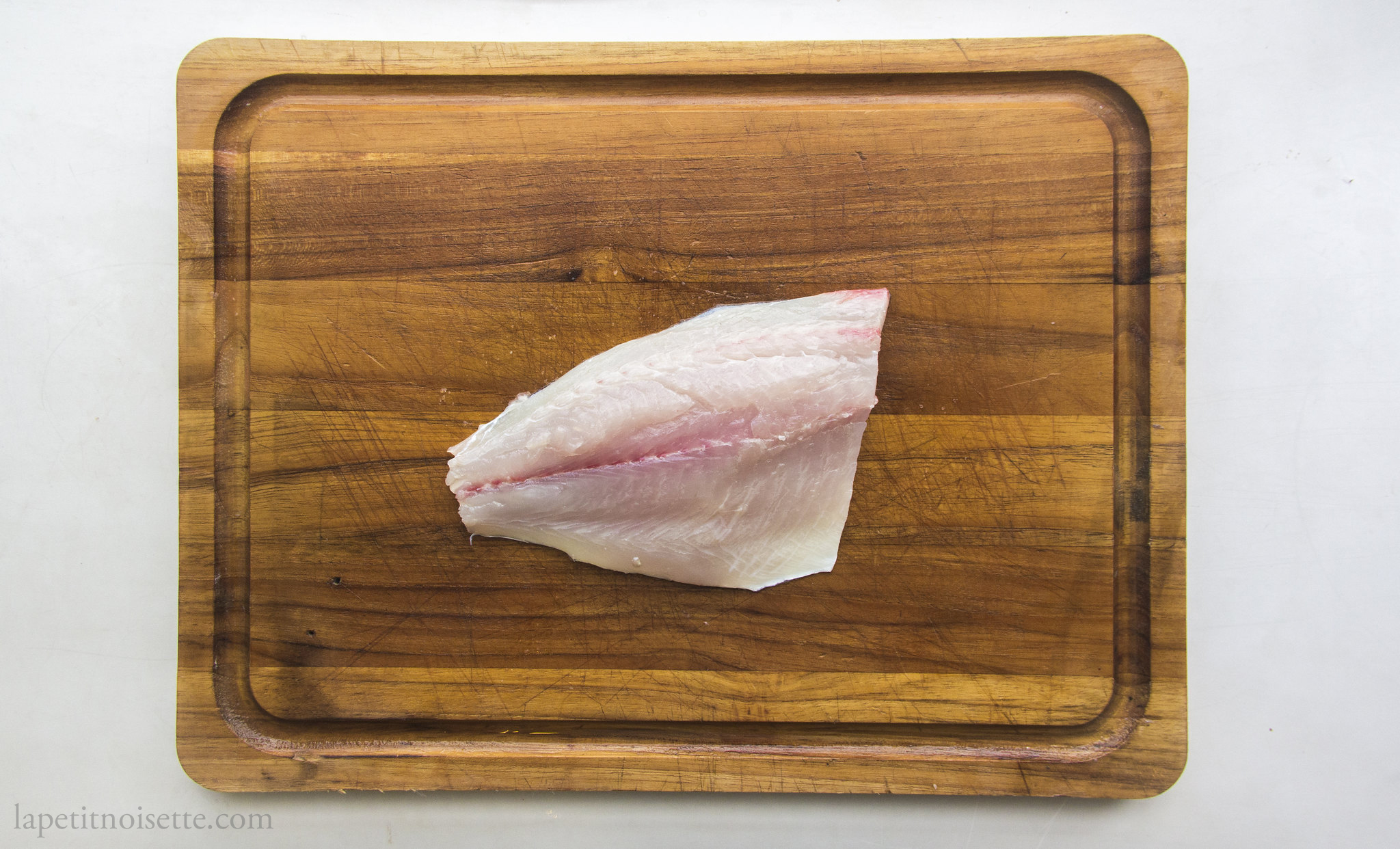
To finish preparing the Shima Aji, repeat for the other side of the fish to extract another fillet.
Generously salt a colander and place the fillets on a colander. Salt the flesh of the fish as well. In the example below, you’d notice that the rib bones were not removed from the fillet when salting. This prevents the fish from being over salted in smaller specimens. If the fish is large, remove the rib bones before salting.
Allow to rest for 20 to 25 minutes depending on the size. During that time, remove the pin bones of the fish. After salting, wash off the salt and place the fillets skin side down on a chopping board.
Prepare a bowl of ice water.
Add soy sauce to the bowl to marinade the Shima Aji.
Squeeze half a Sudachi Lime into the bowl and leave the fruit in the liquid after squeezing.
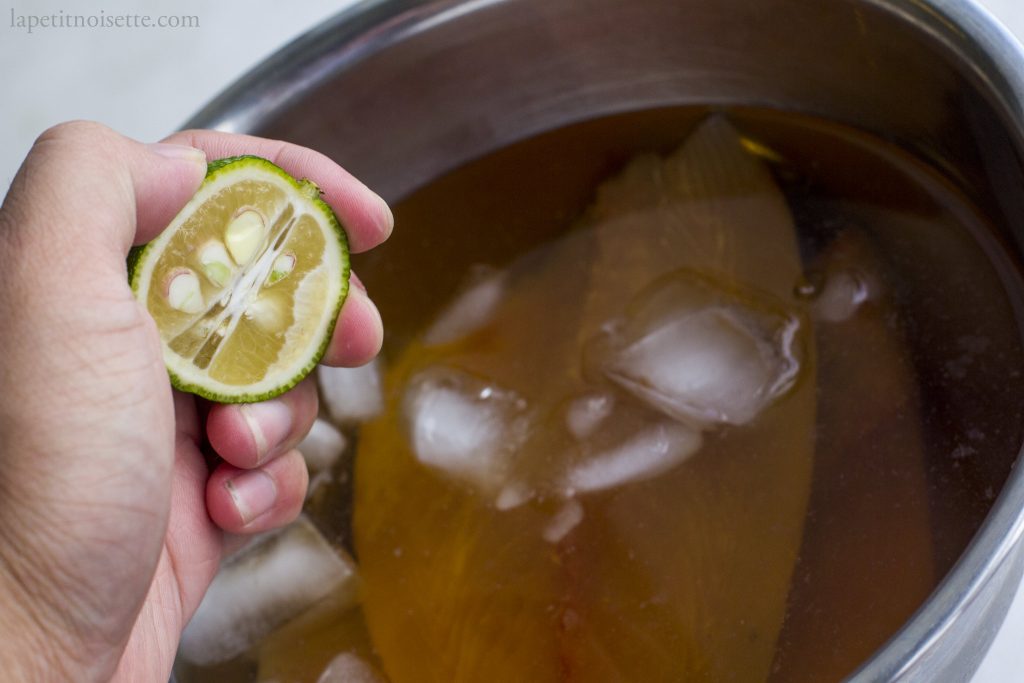
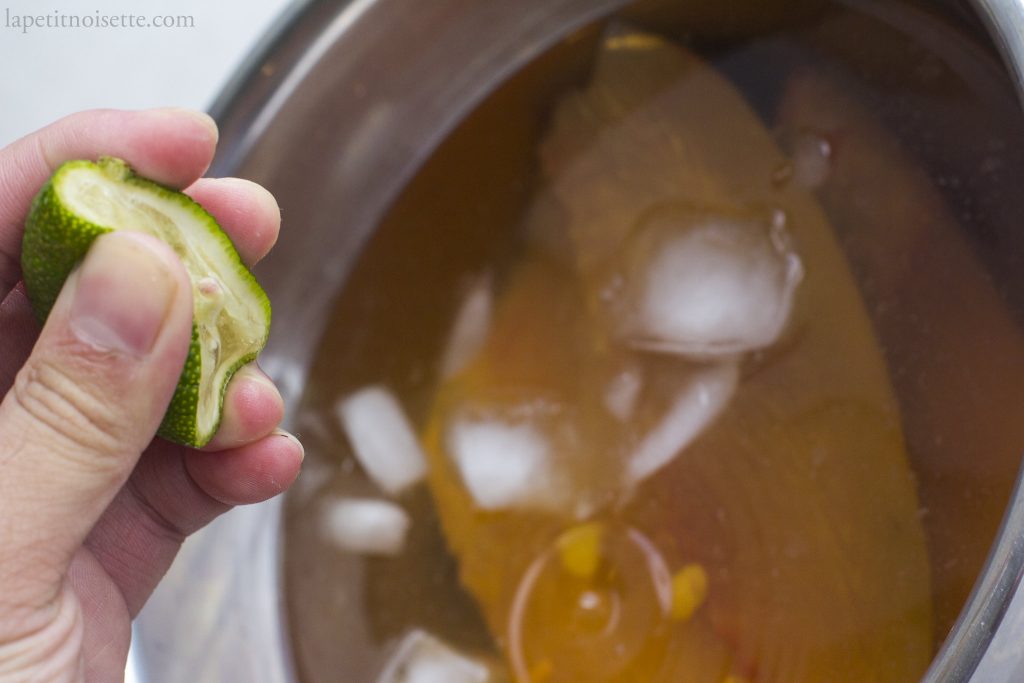
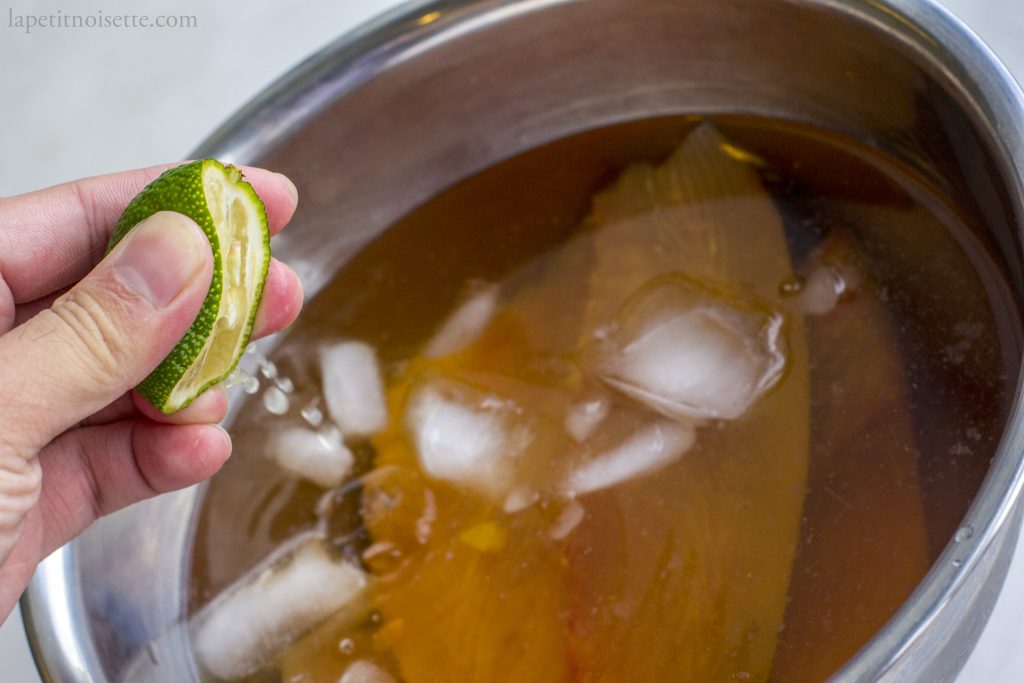
Allow the Shima Aji to marinade for 20 to 25 minutes depending on size before draining.
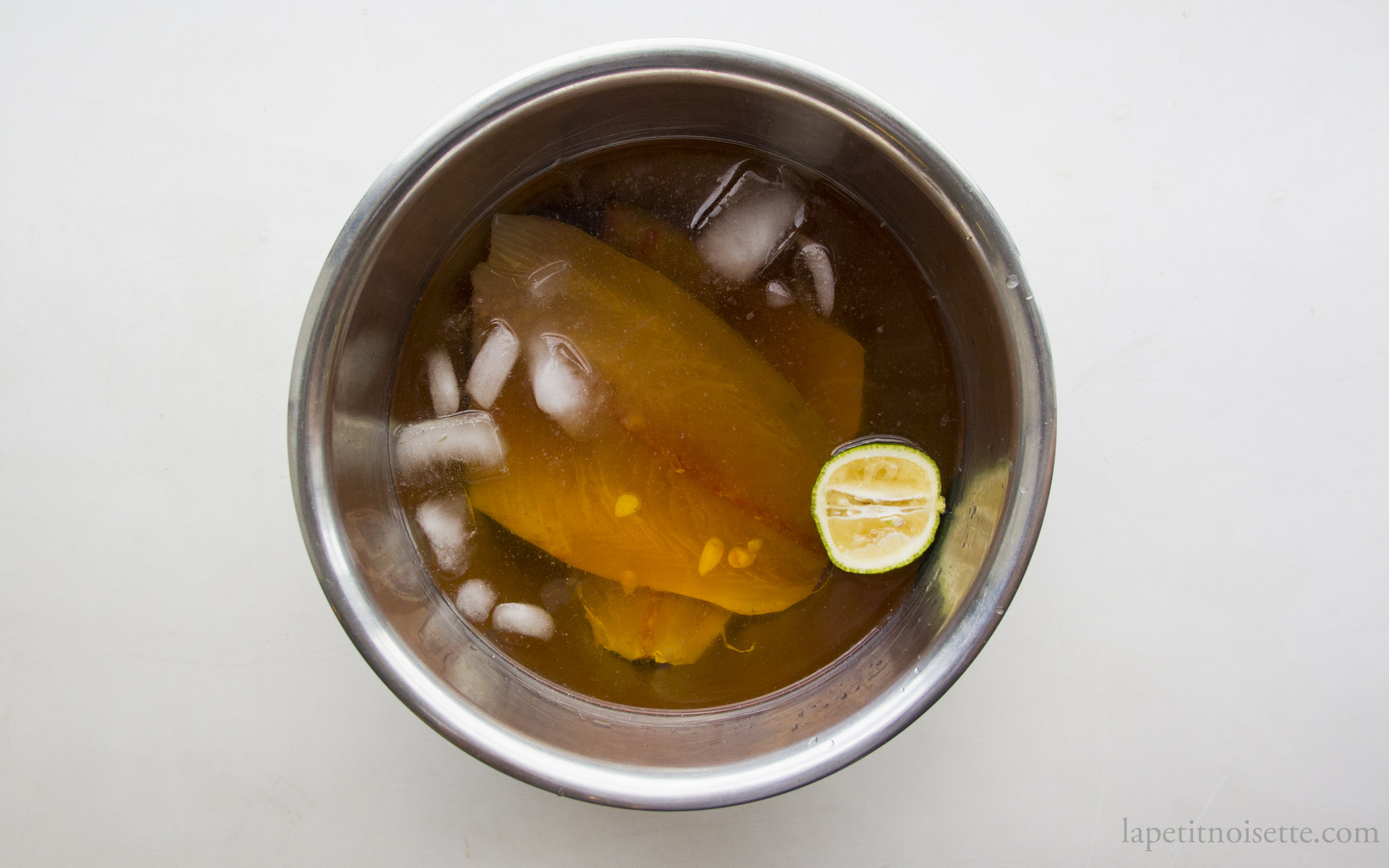
Cut the fillet in half down the lateral line to make it easy to remove the skin.
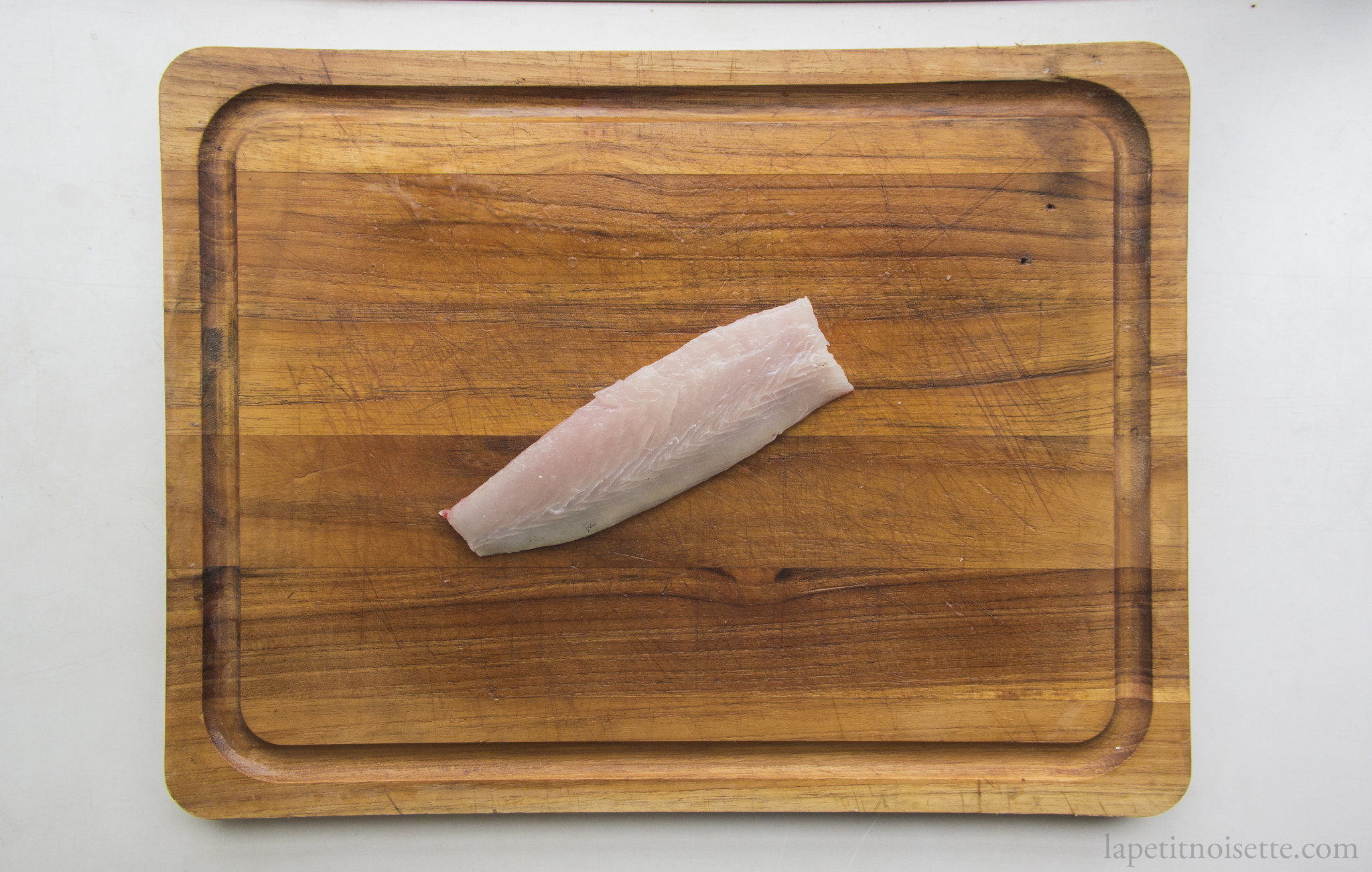
Remove the skin off the fillets by making a small cut underneath the tail of the fillet between the flesh and skin. Start by cutting into the flesh and stopping just at the skin. When the blade just touches the skin, use a back and forth motion on the skin to gently separate the fresh from the skin whilst angling the blade until it is flat. The blade should remain still whilst you only move the skin.
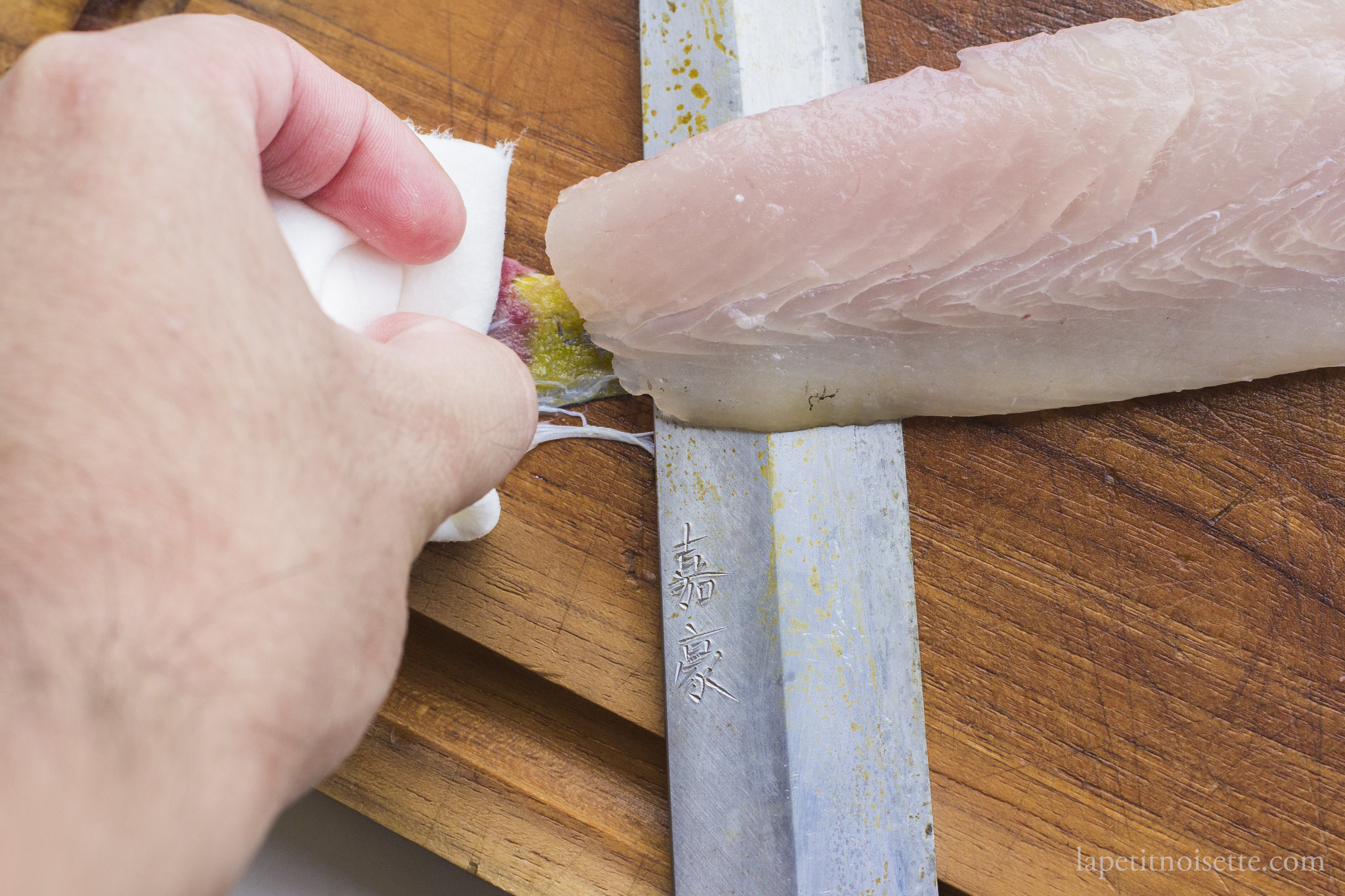
Continue the cutting motion until all the skin has been removed from the flesh. If the skin breaks halfway, don’t worry and start from the other end of the fillet. Using a paper towel to grip the skin of the fish allows you to have a more stable hold on the fillet, making it easier to cut.
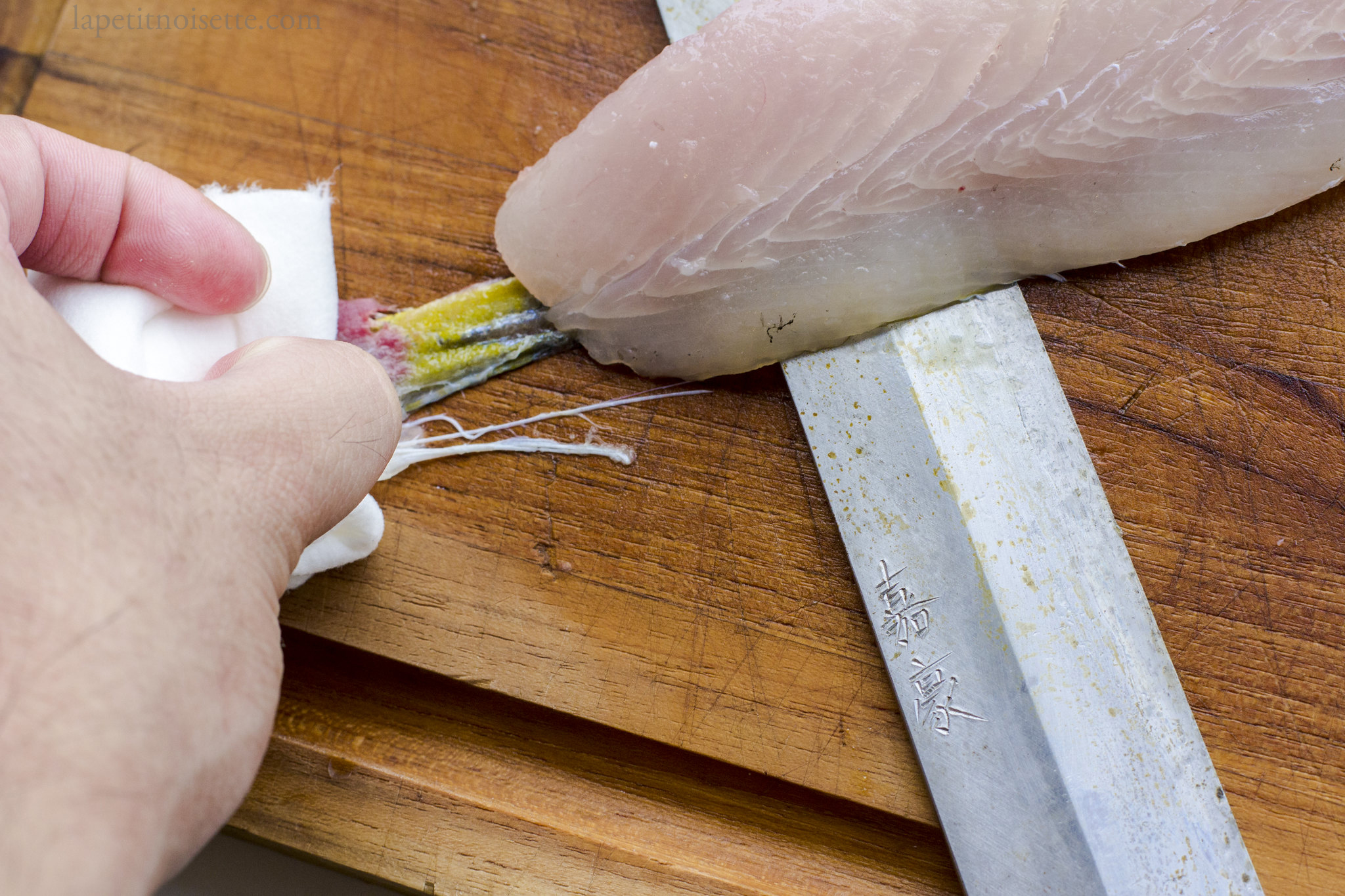
The fish is ready to use.
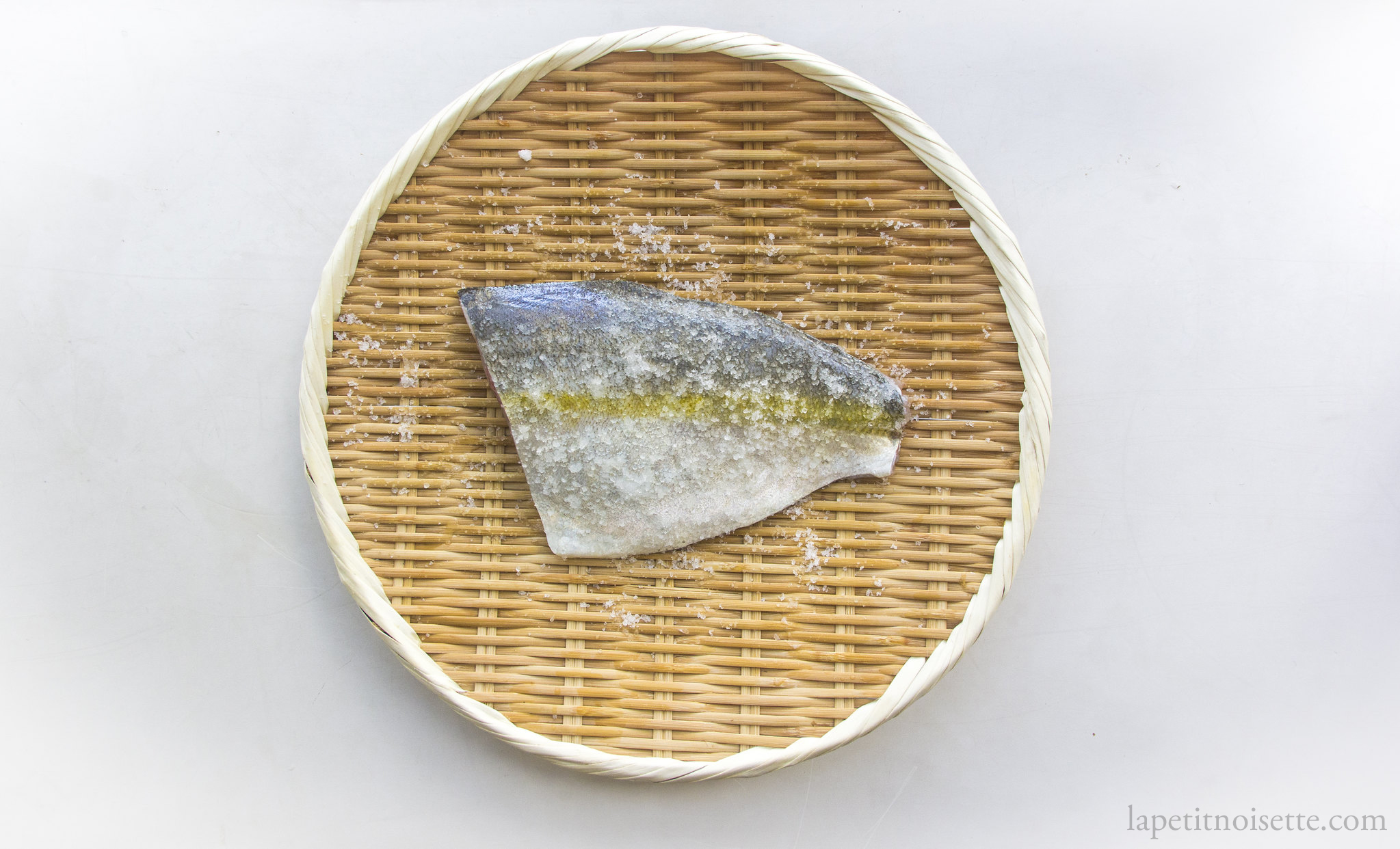
hello chef, what is the ratio of ice water to shoyu for the marinate? Thanks.
I don’t know precisely, as everything in the restaurant was done by eye. If I were to estimate it for you however, it’s probably around 30 to 40ml of shoyu to 500ml of water. The soy sauce is less important than the citrus.
Thank you, chef
Can regular lime replace the sudachi lime?